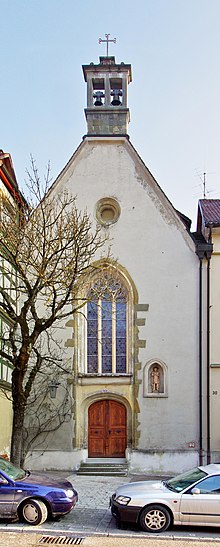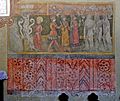St. Jodok (Überlingen)
The Catholic Jodok Church in the so-called village in Überlingen on Lake Constance is a pilgrimage church and is located directly on Via Beuronensis , the part of the Way of St. James between Neckar and Lake Constance on the way from Pfullendorf to Wallhausen . The church is integrated a bit set back in the street row and belongs to the Überlinger Münster parish of St. Nikolaus .
Building history and description
In Überlingen there was also a brotherhood of St. James from the 15th century at the latest . Their purpose was to provide board and lodging for the pilgrims . To do this, they ran a pilgrims' hostel on the so-called Blattergraben , the building stood outside the city between the first and second city wall ring . The pilgrims were allowed to stay there for one night and received an evening snack and morning soup as well as a spare penny. A member of the Überlinger brotherhood could only be who fulfilled the following conditions: "From the beginning of this brotherhood nobody was accepted into it, he then ain Walfart either called Sanct Jacob to Compostell in Hispania, called Rome to St. Peter, called St. Iodine in Picardia or to our dear Frauwen in Niderlandt in Aach volnbracht. "
The Jodok Church was donated by the wealthy Überlingen citizen Burkhart Hipp in 1424. In 1462, at the height of the Jacobean movement, it was consecrated as the Church of the Brotherhood of St. Jodok . This can be seen on the keystone in the choir vault , which represents the saint. To the right of the entrance portal is a statue of St. Jodokus in a niche (picture 7 in the gallery). It can be recognized by its attributes - the pilgrim's staff and the pilgrim's hat with a shell. The church itself is a simple late Gothic building. The street facade shows an ogival tracery window with three nuns' heads and two four-passports above the portal . In the bell tower hang two bells, the left of which shows the saint.
Distinctive grinding marks can be seen on the walls of the entrance portal. The probable cause for this is that sparks were rubbed in there to make the fire. Of course, local legends are associated with it, on the one hand that the vintners who lived here in the village sharpened their sickle-shaped knives there to receive God's blessing for their work, on the other hand there is the legend of the foundation of the Überlingen sword dance .
In the 18th century some alterations were made to the church, with the baroque furnishings ( altar ); two new windows in the north wall and an organ gallery . Over time, the Jodok Church became so dilapidated that it threatened to collapse around 1835. After founding a Jodok club , renovation work could be carried out. The church was consecrated again in 1934 after having been profaned around twenty years earlier .
The church is still used for church services today, and concerts from all areas of music are regularly held there by the “St. Jodok Concert Series” association .
The Jodok Church is usually locked, but pilgrims and those interested receive the key and pilgrim stamp from the custodians or in the Catholic rectory on Münsterplatz. Up until a few years ago you could borrow the key from an adjoining (now closed) bookstore.
Furnishing
The gallows and chicken miracle , actually the legend of Jacob, is depicted on the north wall of the interior in 12 frescoes from the second half of the 15th century (picture 5 in the gallery). The artist is believed to be among the illustrators of the Richenthal Chronicle of the Council of Constance . Another representation of the scene can be seen as a red chalk painting on the gallery (picture 8 in the gallery). On the southern side, the three living and the three dead (picture 1 in the gallery) of a pre-form of the death dances are shown. In further frescoes the holy sorrow (picture 4 in the gallery, far right) and the 15, here not 14, helpers in need are shown. The frescoes were covered with plaster during the renovation work in the 18th century until they were exposed again by the restorer and painter Victor Mezger around 1903 (the important wall paintings in the Goldbach New Year's Chapel were also exposed again by the Mezger restoration workshop).
If you look into the sacristy, there is a holy James as a late Gothic guild pole figure. The high altar is decorated with a crucifixion group, behind which St. Rochus, the pilgrim saint, stands with scallops on the robe, the putti carry the pilgrim's staff and the calabash (picture 6 in the gallery).
Web links and literature
- Jodokkirche Münster community in Überlingen
- Page of the concert series St. Jodok
- The fifteen emergency helpers from St. Jodok in Überlingen, Ulrich Köberle, 2010
- Hans Georg Wehrens: The dance of death in the Alemannic language area. "I have to do it - and don't know what" . Schnell & Steiner, Regensburg 2012, p. 32f. ISBN 978-3-7954-2563-0 . P. 32, 33.
- Marion Harder-Merkelbach, Michael Brunner (ed.): 1100 years of art and architecture in Überlingen (850–1950). Book accompanying the exhibition at the Städtische Galerie Überlingen. Imhof Verlag, Petersberg 2005, ISBN 3-86568-032-1 .
- Alois Schneider, Regional Council Stuttgart, State Office for Monument Preservation, City of Überlingen (ed.): Archaeological City Register Baden-Württemberg Volume 34 Überlingen. Regional Council Stuttgart State Office for Monument Preservation 2008, ISBN 978-3-927714-92-2 .
- Building history and building description Gerhard Elsner: The Jodok Church in Überlingen, fourth improved edition 2009
Individual evidence
- ↑ Display board at the church
- ^ Theodor Lachmann, Überlinger Sagen, Customs and Sitten. Konstanz 1909, No. 10, p. 44
- ↑ https://www.muenstergemeinde-ueberlingen.de/html/jodokkirche884.html
- ↑ https://www.ueberlingen-bodensee.de/Media/Sehenswerte/St.-Jodok-Kirche
- ↑ Hans Georg Wehrens: The dance of death in the Alemannic language area, role models-distribution-significant representations . In: Journal of the Breisgau history association "Schau-ins-Land". Volume 128, 2009, pp. 21-58.
Coordinates: 47 ° 46 ′ 11.1 " N , 9 ° 9 ′ 32.2" E









